Text
The Prize to Doke Brothers — Mizunami, September 1565

There were brothers, Doke Seijuro, Doke Kojuro, from Owari Province, living in Moriyama. Several years ago, Takeda Shingen invaded Kono-guchi in the east of Mino Province. Then Mori Sanzaemon and Hida Genba took the lead in the battle, the armies fought in the mountains and valleys. The brothers took three enemies' heads and brought them to Nobunaga who exceptionally praised them. The brothers wore a white banner, on which Nobunaga handwrote "The Best Hero in The Country". Nothing is more honorable than this, the brothers were the people of honor.(The Chronicle of Lord Nobunaga, Ota Gyuichi(1527-1613))
道家清十郎・道家功十郎とて、兄弟覚えの者あり。生国 尾張 守山の住人なり。一年、東美濃 高野口 (岐阜県瑞浪市) へ 武田信玄 相働き侯、その時、 森三左衛門 ・
肥田玄蕃 先懸けにて、山中・谷合いにて懸かり合い、相戦いて、兄弟して頸 3つ取りて参り、信長公の御目に懸け侯へば、御褒美 斜めならず。白き旗を差し物に仕り侯。その旗を召し寄せられ、「 天下一の勇士なり 」と御自筆に遊ばし付けられ侯て下さる。都鄙の面目、これに過ぐべからず、名誉の仁にて侯なり。(信長公記)
0 notes
Text
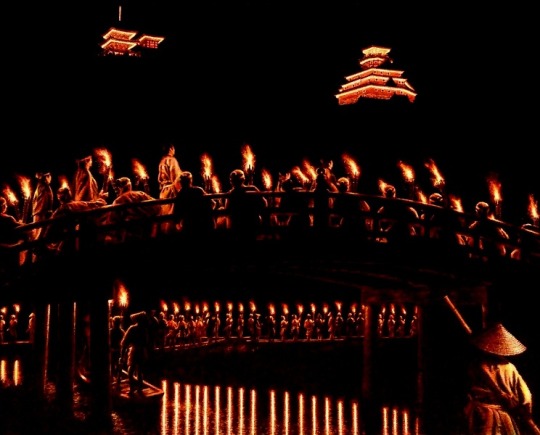
The Last Urabon Festival — Azuchi, 14 August 1581
Every year vassals make a bonfire in front of their own houses, and nothing was burnt at Nobunaga's castle, but that night the complete reverse happened. That is, Nobunaga forbade any vassals from burning fire in front of the house, and only he had the upper castle tower decorated with colourful and gorgeous beautiful lanterns. With verandas surrounding the seven floors, it towered high, and innumerable lanterns looked like burning in the sky, giving a vivid landscape.
He gathered a large crowd of people holding torches on the street which started at a corner of our monastery, passed in front of it, and got to the foot of the castle hill, and arranged the people neatly on both sides of the long street. Many high-ranking young samurais and soldiers ran down the street. The torches are made of reeds, so when burning out, they emitted sparks. Those who held it intentionally showered sparks on the ground.The streets were filled with these fire, and young samurais ran over them. After a considerable amount of time, as the priests, monks, and children of Seminario relaxed and watched the festival fire through the windows, Nobunaga walked past the entrance to our monastery. The missionary and the other priests went out and took a deep bow to please him, Nobunaga chatted with them for a long time, asked if they had seen the festival, what they thought about it, and after asking a variety of other questions, he left them.(History of Japan, Luis Frois)
0 notes
Text
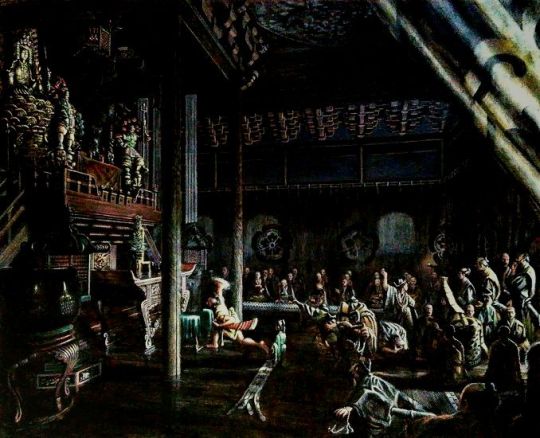
Shoko —Nagoya, 14 May 1552
Nobuhide, suffering from an epidemic, got various prayers and treatments, but he did not heal and finally on 3 March, passed away as young as 42 years old. Life is ephemeral, as usual; it is sad. It is just like a wind blows off dews on thousands of grass leaves, or like an endless cloud spreads out to hide the light of the full moon.
While alive he built a temple and named it Banshoji. Named Togen as a posthumous name, he was celebrated by holding an alms-giving ceremony, inviting priests from all over the province; it became a big funeral ceremony.
At that time trainee monks travelled up and down the road to Kanto region. There were about 300 monks, Nobunaga's companions are the chief retainers - Hayashi, Hirate, Aoyama, and Naito. His younger brother, Kanjuro, was accompanied by his vassals, Shibata Gonroku, Sakuma Daigaku, Sakuma Jiuemon, Hasegawa, Yamada and so on.
Nobunaga showed up to burn incense. Nobunaga, then, armed with a long-handled sword and a wakizashi wrapped with straw ropes, with his hair tied into a chasen-shaped topknot, without wearing hakama trousers, went to the altar of Buddha, grabbed a handful of incense powder, hurled it to the altar, and went home. His yonger brother, Kanjuro, wearing a sharply creased kataginu vest and hakama trousers, followed the custom in the correct manner. The people variously said that Nobunaga was a great fool as had been rumoured. Among them, a travelling monk from Tsukushi Province, reportedly, said that that was the man who shall be the Landlord.(Ota Gyuichi, The Chronicle of Lord Nobunaga)
信長、御焼香に御出づ。其の時の信長公御仕立、長つかの大刀、わきざしを三五なわにてまかせられ、髪はちやせんに巻き立て、袴もめし候はで、仏前へ御出でありて、抹香をくはつと御つかみ候て、仏前へ投げ懸け、御帰る。御舎弟勘十郎は折目高なる肩衣、袴めし候て、あるべき如きの御��汰なり。三郎信長公を、「例の大うつけよ」と、執々評判候ひしなり。其の中に筑紫の客僧一人、「あれこそ国は持つ人よ」と、申したる由なり。(信長公記)
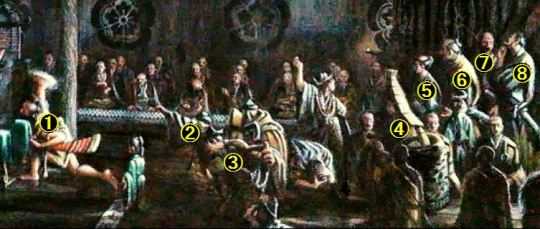

0 notes
Text
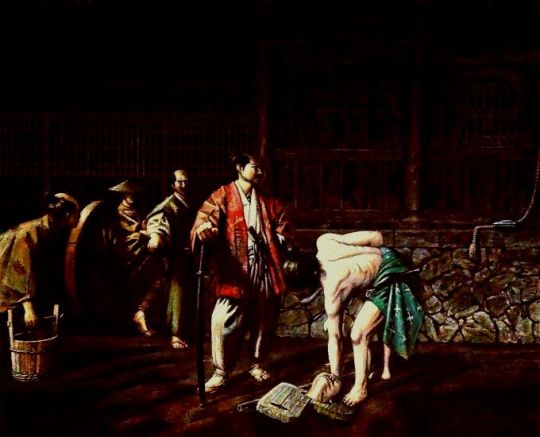
The Beheading of Sugitani Zenjubo —Gifu, 5 October 1573
Sugitani Zenjubo, incidentally, was a good sniper. Years ago, when Nobunaga crossed the Chigusa Mountain Pass, Sugitani, asked by Rokkaku Yoshikata, in the mountain, loading a gun with two bullets, fired ruthlessly from a distance of from 22 to 24 meters. However, the bullets grazed Nobunaga's body, as god of heaven watched over him. Nobunaga, getting off the hook, returned to Gifu.
Around this time, Sugitani Zenjubo hid in Takashima, relying on Namazue Kouchiku. Isono Tanba arrested him, and on 10 September, sent him to Gifu. Sugaya Kyuuemon and Hafuri Yosaburo, both as magistrates, questioned him about the detail of his firing a gun in the Chigusa Mountain, and then executed him in a satisfactory manner: he was buried upright, and beheaded by a saw. All the people, venting years of anger, could not be more satisfied with this.(Ota Gyuichi, The Chronicle of Lord Nobunaga)
0 notes
Text
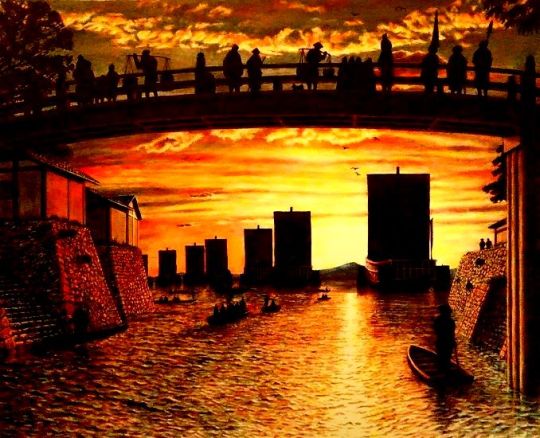
The Arrival of Kuki's Fleet at Sakai —Sakai, 20 August 1578
Kuki Umanojo of Ise Province was ordered to build six large ships, as well as Takigawa Sakon was to build one large ship, which was built as a white ship. Waiting for a fair wind, they set sail to Kumano Bay on June 26th. While the ships navigating toward Osaka, on the offshore of Tannowa, innumerable small boats from Saika, Tannowa, and many bays, in order to stop the large ships, rushing, shooting arrows and muskets, attacked the ships from all sides. Kuki Umanojo, decorating the seven large ships like mountains, accompanied by small vessels, having the enemy boats to come closer, handled them as if welcoming them, then fired a salvo with the cannons and destroyed a lot of enemy boats. Thereafter, the enemies had no way to come close. On July 17th, without any trouble, the ships arrived at the port of Sakai. Crowds were astonished. Following day, the fleet pressed on to Osaka, where the ships were located close to the other, blocked the waterway, strengthened the siege.(Ota Gyuichi, The Chronicle of Lord Nobunaga)
0 notes
Text
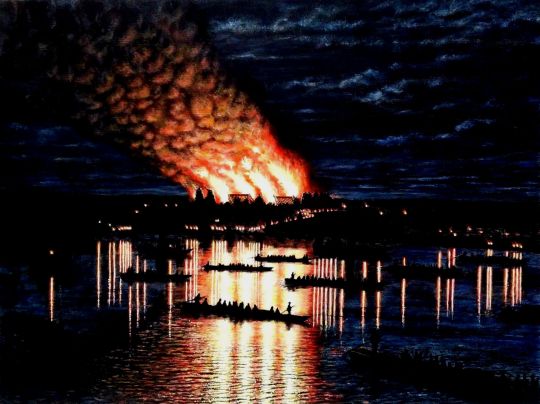
The Burning of Honganji Temple —Osaka, 11 September 1580
On August 2, 14:00, hundreds of boats were called from Saika and Awaji Island to pick up the people including those who were in recent years deployed at the redoubts. They, turning to their relatives, departed hither and thither, both on sea and land as if baby spiders spread, The time has finally arrived, and the westerly wind blows over the torch fire, burning down plenty halls, leaving none of them, for three days and nights, they burned to become a black cloud.(Ota Gyuichi, The Chronicle of Lord Nobunaga)
0 notes
Text
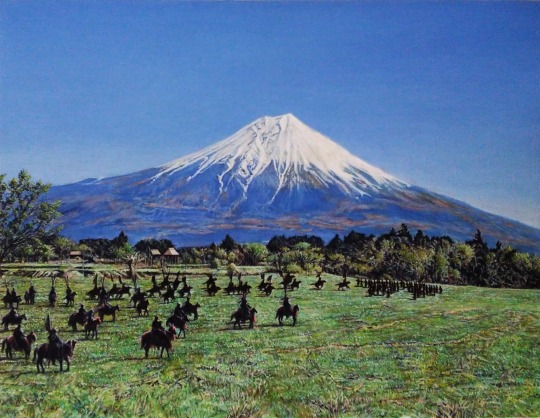
Nobunaga's troops march at the foot of Mount Fuji — Fujinomiya, 4 May 1582
On April 12, Nobunaga left Motosu at dawn. It was cold as midwinter. At Kaminogahara and Ideno at the foot of Mount Fuji, Nobunaga allowed all the guards troops to gallop the horse aggressively, play "okurui", He saw the Mount Fuji which was crowned with snow like a white cloud. It is really an unusually great mountain.(Ota Gyuichi, The Chronicle of Lord Nobunaga)
0 notes
Text

Nobunaga's troops march at the foot of Mount Fuji — Fujinomiya, 4 May 1582
On April 12, Nobunaga left Motosu at dawn. It was cold as midwinter.
At Kaminogahara and Ideno at the foot of Mount Fuji, Nobunaga allowed all the guards troops to gallop the horse aggressively, play "okurui", He saw the Mount Fuji which was crowned with snow like a white cloud. It is really an unusually great mountain.(Ota Gyuichi, The Chronicle of Lord Nobunaga)
0 notes
Text

Ranjatai Cutting — Nara, 19 April 1574
On March 28th, around 8 am, they opened the treasure house. The famous incecnse wood was housed in a 1.8 meter cabin. Soon it was carried to the Tamon Castle, where on the stage in the reception hall it was displayed to Nobunaga. In accordance with the rules, a piece of 5.5 cm was cut. Nobunaga told the entourage guards to look at it, since it was to be the story told to their descendants. They saw it, thanks to Nobunaga's power, and to his compassion, It was the lifelong memory; Words cannot express how thankful we are.(Ota Gyuichi, The Chronicle of Lord Nobunaga)
0 notes
Text
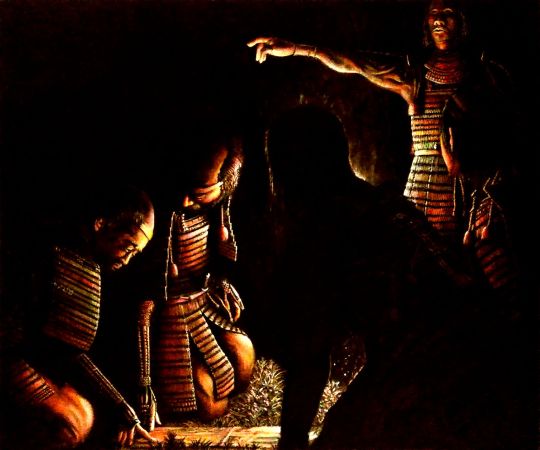
The Crossroads — Yogo, 9 September 1573
As expected, the soldiers attacked the fleeing Asakura troops, killed them, and brought back their heads one after another. Nobunaga, then mounted, went ahead of the army where his generals discussed; "The enemy divided to retreat, taking two routes: Nakanokawachi route and Tone route. Which way should we take?" While their arguments were diverse, Nobunaga decided, "They must retreat toward their allies' castles at Hikita and Tsuruga, so, march the troops on the Hikita route". (Ota Gyuichi, The Chronicle of Lord Nobunaga)
0 notes
Text
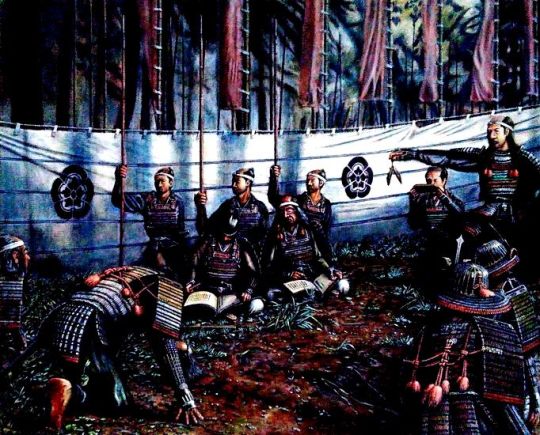
Tonezaka, 10 September 1573
Nobunaga ordinary carried on his waist a pair of ashinaka sandals. This time in the Tone Mountain, Kanematsu Matashiro chased a mounted samurai soldier in the mountain, and eventually killed him, and brought the enemy's head back to Nobunaga. At that time, Kanematsu was barefoot, and his feet were bleeding red. Nobunaga seeing him said "these will be useful" and gave to Kanematsu the ashinaka sandals that Nobunaga ordinarily carried on his waist. It was the ultimate bliss, it was the honor. (Ota Gyuichi , The Chronicle of Lord Nobunaga)
0 notes
Text
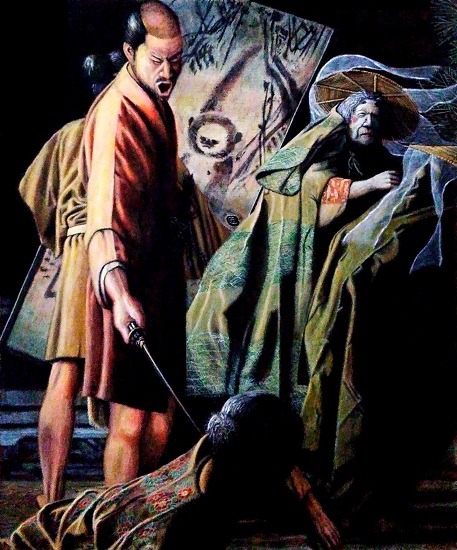
Kyoto, April 1569
By the way, when a soldier once tried playfully to look at a noble lady's face and raised her hat a little while doing the construction work, Nobunaga happened to witness it and in front of the audience immediately decapitated him. (Luis Frois , History of Japan)
1 note
·
View note